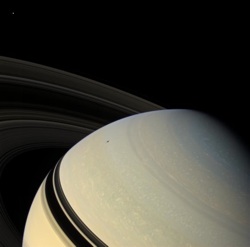A magazine where the digital world meets the real world.
On the web
- Home
- Browse by date
- Browse by topic
- Enter the maze
- Follow our blog
- Follow us on Twitter
- Resources for teachers
- Subscribe
In print
What is cs4fn?
- About us
- Contact us
- Partners
- Privacy and cookies
- Copyright and contributions
- Links to other fun sites
- Complete our questionnaire, give us feedback
Search:
Secret words in space

The news of a new planet’s discovery could be sitting right on an American astronomer’s blog. If you want to find out for sure, though, you’ll have to solve a puzzle. Back in May, Gregory Laughlin posted the phrase ‘Huge Applet, Unsearchable Terrestrials!’ on his blog, leaving readers to ponder what it could mean. Laughlin left a bit of a clue in the same post by telling the story of anagram puzzles in the history of astronomy.
Anagrams are phrases whose letters spell something different when you unscramble them. For example, the word ‘astronomer’ itself can be rearranged to get ‘moon starer’. For hundreds of years, moon starers have been using anagrams in a surprising way: to make sure they get credit for the heavenly objects they discover.
Getting scooped
Ever since the invention of the telescope, loads of people have turned their attention skyward in the hopes of finding something new. With so many people looking, there comes one big danger. Whenever astronomers make a discovery, they have to worry that someone else might be staring at their exciting find at the same time. If a rival got the word out first, you lose the credit and the glory. Shout about your discovery too soon and you could look a fool if you turn out to be wrong.
To get around this threat, astronomers have sometimes hidden their discoveries in word puzzles. This buys them a bit of time to look closer and make sure they’re right. If it turns out they’re wrong, they can ignore the anagram they made up earlier, but if they’re right they reveal the solution to the puzzle. Hey presto, it’s proof they already knew about the discovery, hopefully before any rival claim.
Unscrambling Saturn

It might sound like a weird solution, but it’s got a prestigious history. None other than the Tough Guy From Tuscany himself, Galileo Galilei, used anagrams to disguise his discoveries of Saturn and the phases of Venus. He even got all classical about Venus in his secret message, poetically referring to its mythological history as ‘the Mother of Loves’. Aww.
The Dutch astronomer Christiaan Huygens didn’t seem to put in quite so much effort in 1656. His anagram was just a big list of letters. When it was unscrambled, though, it contained the completely astonishing discovery of Saturn’s rings.
Now in 2008, Greg Laughlin’s blog post has put a computerised twist on the old anagram strategy. He’s got a taste of fame already, since his tantalising post was reported in the prestigious journal Nature. He’s also snared lots of visitors to his blog, who’ve come to guess at what his puzzle could mean. Just think how well he’ll do if he can reveal the solution and claim his place in astronomical history – not only for his discovery, but for being pretty crafty with words too.
Saturn photo credit: NASA/JPL/Space Science Institute


